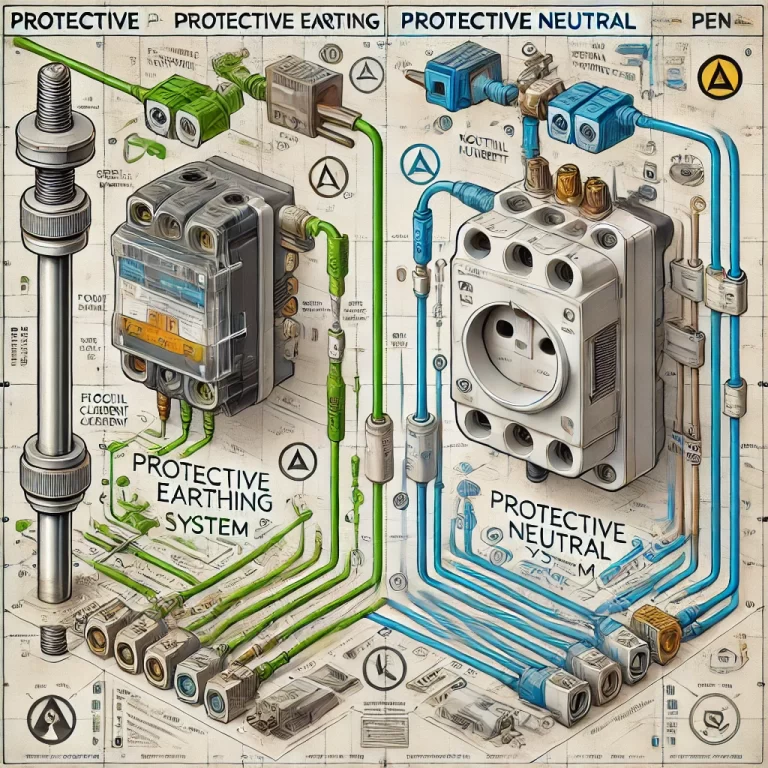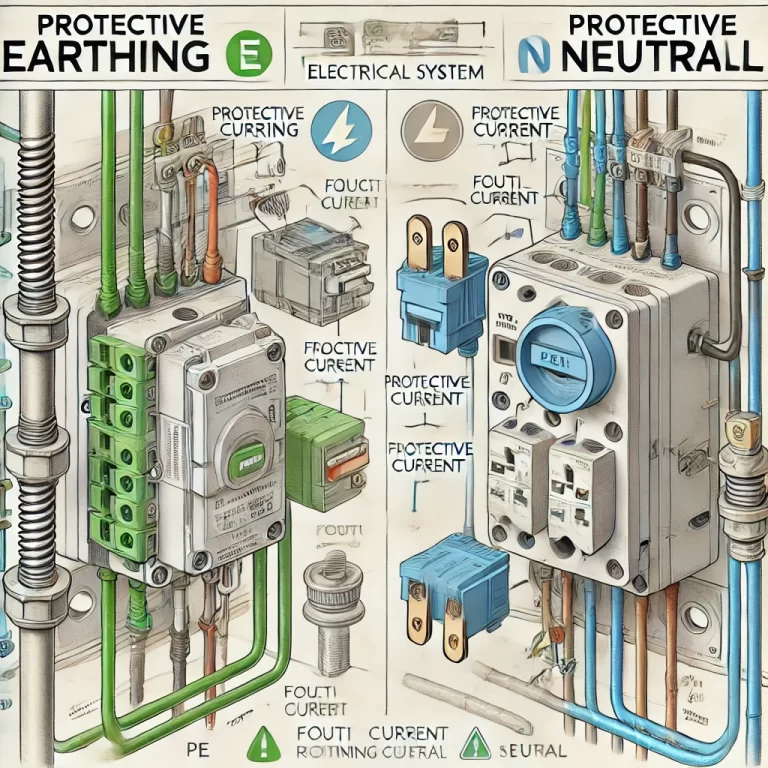Electrical safety is a critical aspect of any power distribution system, and two essential protective measures are Protective Earthing (PE) and Protective Neutral (PEN). While both systems aim to prevent electric shocks and safeguard equipment, their working principles, implementation, and safety features differ significantly. This article explores these two safety mechanisms in detail.
1. Protective Earthing (PE)
Definition: Protective Earthing involves connecting the exposed conductive parts of electrical equipment directly to the ground. This ensures that, in the event of a fault where a live conductor comes into contact with a metal casing, the fault current will safely dissipate into the earth.
Applicable Systems: Protective Earthing is commonly used in TN-S (Terra Neutral-Separated) and TT (Terra-Terra) systems.
Working Principle: When a fault occurs and a live wire contacts the metal casing of an appliance, the current is directed through the earthing conductor into the ground. This sudden surge in current triggers protective devices like Residual Current Devices (RCDs) or circuit breakers to disconnect the power supply, mitigating the risk of electric shock.

Advantages:
High Safety Reliability: The direct connection to the ground ensures that fault currents have a low-resistance path to dissipate safely.
Effective Fault Clearing: High fault current levels enable quick activation of protective devices.
Disadvantages:
Higher Installation Costs: Requires dedicated grounding rods or plates.
Dependent on Soil Conditions: Effectiveness can vary based on ground resistance, especially in dry or rocky areas.
Typical Applications: Protective Earthing is ideal for environments with scattered installations such as rural areas, construction sites, and outdoor electrical systems.
2. Protective Neutral (PEN)
Definition: Protective Neutral involves connecting the exposed metal parts of electrical equipment to the system’s neutral line. This method leverages the neutral conductor to carry fault currents back to the source.
Applicable Systems: Protective Neutral is typically used in TN-C (Terra Neutral-Combined) and TN-C-S (Terra Neutral-Combined and Separated) systems.
Working Principle: In the event of a fault, the fault current flows through the neutral conductor back to the power supply’s neutral point. The increase in current activates overcurrent protective devices (such as fuses or circuit breakers), promptly disconnecting the faulty circuit.
Advantages:
Cost-Effective: Eliminates the need for separate grounding conductors, reducing material and labor costs.
Simplified Installation: Easier to implement in densely populated areas with complex wiring systems.
Disadvantages:
Risk of Neutral Breakage: If the neutral conductor breaks, the exposed parts of the equipment may become live, posing a serious electric shock hazard.
Shared Path for Load and Fault Currents: Can lead to potential electromagnetic interference and voltage fluctuations.
Typical Applications: Protective Neutral is commonly used in urban electrical networks, industrial facilities, and centralized power distribution systems.
3. Key Differences Between Protective Earthing and Protective Neutral
| Aspect | Protective Earthing (PE) | Protective Neutral (PEN) |
|---|---|---|
| Connection | Connected to an independent ground rod or plate | Connected to the system’s neutral conductor |
| Fault Current Path | Flows into the earth | Flows back to the power source via neutral |
| Safety | More reliable; less risk of electric shock | Riskier if neutral conductor breaks |
| Installation Cost | Higher due to additional grounding equipment | Lower due to shared conductors |
| Applications | Rural, construction sites, outdoor systems | Urban networks, industrial settings |
4. Combined Use of PE and PEN Systems
Modern electrical systems often combine both Protective Earthing and Protective Neutral to maximize safety. For example, the TN-C-S system initially shares the neutral and protective functions (PEN) and later separates them (PE and N) closer to the load. This hybrid approach balances cost-efficiency and safety.

5. Conclusion
Understanding the distinct roles of Protective Earthing and Protective Neutral is crucial for designing and maintaining safe electrical systems. Protective Earthing offers superior safety by providing a direct path to ground, while Protective Neutral is more cost-effective but requires careful maintenance to prevent hazards. The choice between these methods depends on specific installation environments, safety requirements, and economic considerations. Prioritizing the correct grounding method ensures both human safety and the protection of valuable electrical equipment.
